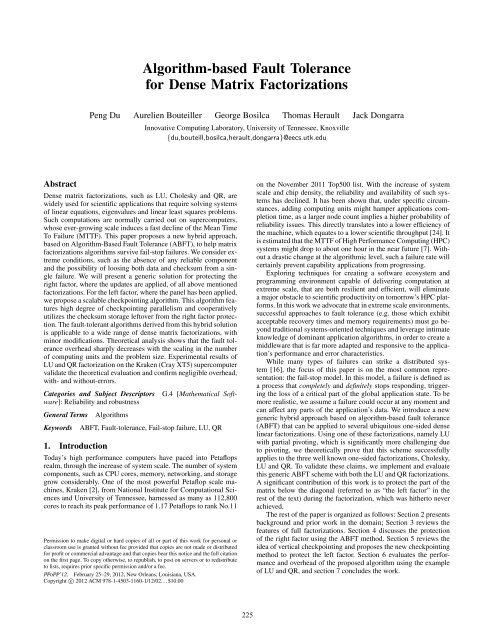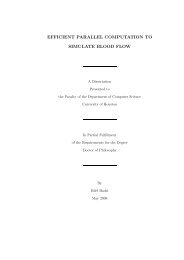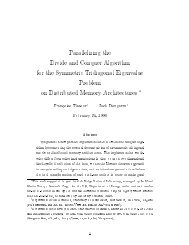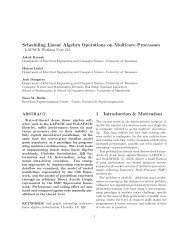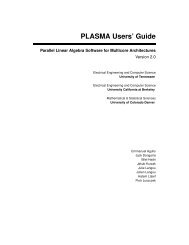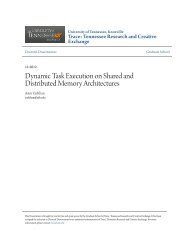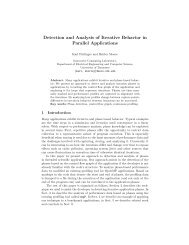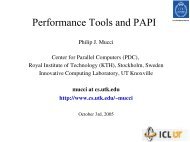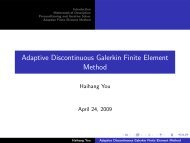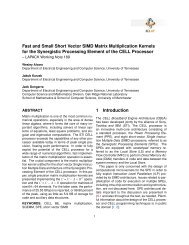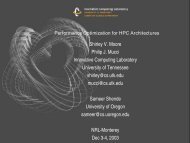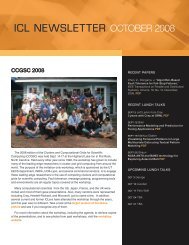Algorithm-based fault tolerance for dense matrix factorizations
Algorithm-based fault tolerance for dense matrix factorizations
Algorithm-based fault tolerance for dense matrix factorizations
Create successful ePaper yourself
Turn your PDF publications into a flip-book with our unique Google optimized e-Paper software.
<strong>Algorithm</strong>-<strong>based</strong> Fault Tolerance<br />
<strong>for</strong> Dense Matrix Factorizations<br />
Peng Du Aurelien Bouteiller George Bosilca Thomas Herault Jack Dongarra<br />
Innovative Computing Laboratory, University of Tennessee, Knoxville<br />
{du,bouteill,bosilca,herault,dongarra}@eecs.utk.edu<br />
Abstract<br />
Dense <strong>matrix</strong> <strong>factorizations</strong>, such as LU, Cholesky and QR, are<br />
widely used <strong>for</strong> scientific applications that require solving systems<br />
of linear equations, eigenvalues and linear least squares problems.<br />
Such computations are normally carried out on supercomputers,<br />
whose ever-growing scale induces a fast decline of the Mean Time<br />
To Failure (MTTF). This paper proposes a new hybrid approach,<br />
<strong>based</strong> on <strong>Algorithm</strong>-Based Fault Tolerance (ABFT), to help <strong>matrix</strong><br />
<strong>factorizations</strong> algorithms survive fail-stop failures. We consider extreme<br />
conditions, such as the absence of any reliable component<br />
and the possibility of loosing both data and checksum from a single<br />
failure. We will present a generic solution <strong>for</strong> protecting the<br />
right factor, where the updates are applied, of all above mentioned<br />
<strong>factorizations</strong>. For the left factor, where the panel has been applied,<br />
we propose a scalable checkpointing algorithm. This algorithm features<br />
high degree of checkpointing parallelism and cooperatively<br />
utilizes the checksum storage leftover from the right factor protection.<br />
The <strong>fault</strong>-tolerant algorithms derived from this hybrid solution<br />
is applicable to a wide range of <strong>dense</strong> <strong>matrix</strong> <strong>factorizations</strong>, with<br />
minor modifications. Theoretical analysis shows that the <strong>fault</strong> <strong>tolerance</strong><br />
overhead sharply decreases with the scaling in the number<br />
of computing units and the problem size. Experimental results of<br />
LU and QR factorization on the Kraken (Cray XT5) supercomputer<br />
validate the theoretical evaluation and confirm negligible overhead,<br />
with- and without-errors.<br />
Categories and Subject Descriptors G.4 [Mathematical Software]:<br />
Reliability and robustness<br />
General Terms <strong>Algorithm</strong>s<br />
Keywords ABFT, Fault-<strong>tolerance</strong>, Fail-stop failure, LU, QR<br />
1. Introduction<br />
Today’s high per<strong>for</strong>mance computers have paced into Petaflops<br />
realm, through the increase of system scale. The number of system<br />
components, such as CPU cores, memory, networking, and storage<br />
grow considerably. One of the most powerful Petaflop scale machines,<br />
Kraken [2], from National Institute <strong>for</strong> Computational Sciences<br />
and University of Tennessee, harnessed as many as 112,800<br />
cores to reach its peak per<strong>for</strong>mance of 1.17 Petaflops to rank No.11<br />
Permission to make digital or hard copies of all or part of this work <strong>for</strong> personal or<br />
classroom use is granted without fee provided that copies are not made or distributed<br />
<strong>for</strong> profit or commercial advantage and that copies bear this notice and the full citation<br />
on the first page. To copy otherwise, to republish, to post on servers or to redistribute<br />
to lists, requires prior specific permission and/or a fee.<br />
PPoPP’12, February 25–29, 2012, New Orleans, Louisiana, USA.<br />
Copyright c 2012 ACM 978-1-4503-1160-1/12/02. . . $10.00<br />
on the November 2011 Top500 list. With the increase of system<br />
scale and chip density, the reliability and availability of such systems<br />
has declined. It has been shown that, under specific circumstances,<br />
adding computing units might hamper applications completion<br />
time, as a larger node count implies a higher probability of<br />
reliability issues. This directly translates into a lower efficiency of<br />
the machine, which equates to a lower scientific throughput [24]. It<br />
is estimated that the MTTF of High Per<strong>for</strong>mance Computing (HPC)<br />
systems might drop to about one hour in the near future [7]. Without<br />
a drastic change at the algorithmic level, such a failure rate will<br />
certainly prevent capability applications from progressing.<br />
Exploring techniques <strong>for</strong> creating a software ecosystem and<br />
programming environment capable of delivering computation at<br />
extreme scale, that are both resilient and efficient, will eliminate<br />
a major obstacle to scientific productivity on tomorrow’s HPC plat<strong>for</strong>ms.<br />
In this work we advocate that in extreme scale environments,<br />
successful approaches to <strong>fault</strong> <strong>tolerance</strong> (e.g. those which exhibit<br />
acceptable recovery times and memory requirements) must go beyond<br />
traditional systems-oriented techniques and leverage intimate<br />
knowledge of dominant application algorithms, in order to create a<br />
middleware that is far more adapted and responsive to the application’s<br />
per<strong>for</strong>mance and error characteristics.<br />
While many types of failures can strike a distributed system<br />
[16], the focus of this paper is on the most common representation:<br />
the fail-stop model. In this model, a failure is defined as<br />
a process that completely and definitely stops responding, triggering<br />
the loss of a critical part of the global application state. To be<br />
more realistic, we assume a failure could occur at any moment and<br />
can affect any parts of the application’s data. We introduce a new<br />
generic hybrid approach <strong>based</strong> on algorithm-<strong>based</strong> <strong>fault</strong> <strong>tolerance</strong><br />
(ABFT) that can be applied to several ubiquitous one-sided <strong>dense</strong><br />
linear <strong>factorizations</strong>. Using one of these <strong>factorizations</strong>, namely LU<br />
with partial pivoting, which is significantly more challenging due<br />
to pivoting, we theoretically prove that this scheme successfully<br />
applies to the three well known one-sided <strong>factorizations</strong>, Cholesky,<br />
LU and QR. To validate these claims, we implement and evaluate<br />
this generic ABFT scheme with both the LU and QR <strong>factorizations</strong>.<br />
A significant contribution of this work is to protect the part of the<br />
<strong>matrix</strong> below the diagonal (referred to as “the left factor” in the<br />
rest of the text) during the factorization, which was hitherto never<br />
achieved.<br />
The rest of the paper is organized as follows: Section 2 presents<br />
background and prior work in the domain; Section 3 reviews the<br />
features of full <strong>factorizations</strong>. Section 4 discusses the protection<br />
of the right factor using the ABFT method. Section 5 reviews the<br />
idea of vertical checkpointing and proposes the new checkpointing<br />
method to protect the left factor. Section 6 evaluates the per<strong>for</strong>mance<br />
and overhead of the proposed algorithm using the example<br />
of LU and QR, and section 7 concludes the work.<br />
225
2. <strong>Algorithm</strong> Based Fault Tolerance Background<br />
The most well-known <strong>fault</strong>-<strong>tolerance</strong> technique <strong>for</strong> parallel applications,<br />
checkpoint-restart (C/R), encompasses two categories, the<br />
system and application level. At the system level, message passing<br />
middleware deals with <strong>fault</strong>s automatically, without intervention<br />
from the application developer or user ([5, 6]). At the application<br />
level, the application state is dumped to a reliable storage<br />
when the application code mandates it. Even though C/R bears the<br />
disadvantage of high overhead while writing data to stable storage,<br />
it is widely used nowadays by high end systems [1]. To reduce<br />
the overhead of C/R, diskless checkpointing [21, 23] has been introduced<br />
to store checksum in memory rather than stable storage.<br />
While diskless checkpointing has shown promising per<strong>for</strong>mance<br />
in some applications (<strong>for</strong> instance, FFT in [14]), it exhibits large<br />
overheads <strong>for</strong> applications modifying substantial memory regions<br />
between checkpoints [23], as is the case with <strong>factorizations</strong>.<br />
In contrast, <strong>Algorithm</strong> Based Fault Tolerance (ABFT) is <strong>based</strong><br />
on adapting the algorithm so that the application dataset can be<br />
recovered at any moment, without involving costly checkpoints.<br />
ABFT was first introduced to deal with silent error in systolic arrays<br />
[19]. Unlike other methods that treat the recovery data and<br />
computing data separately, ABFT approaches are <strong>based</strong> on the idea<br />
of maintaining consistency of the recovery data, by applying appropriate<br />
mathematical operations on both the original and recovery<br />
data. Typically, <strong>for</strong> linear algebra operations, the input <strong>matrix</strong><br />
is extended with supplementary columns and/or rows containing<br />
checksums. This initial encoding happens only once; the <strong>matrix</strong><br />
algorithms are designed to work on the encoded checksum along<br />
with <strong>matrix</strong> data, similar mathematical operations are applied to<br />
both the data and the checksum so that the checksum relationship<br />
is kept invariant during the course of the algorithm. Should some<br />
data be damaged by failures, it is then possible to recover the application<br />
by inverting the checksum operation to recreate missing<br />
data. The overhead of ABFT is usually low, since no periodical<br />
global checkpoint or rollback-recovery is involved during computation<br />
and the computation complexity of the checksum operations<br />
scales similarly to the related <strong>matrix</strong> operation. ABFT and diskless<br />
checkpointing have been combined to apply to basic <strong>matrix</strong> operations<br />
like <strong>matrix</strong>-<strong>matrix</strong> multiplication [4, 8–10] and have been<br />
implemented on algorithms similar to those of ScaLAPACK [3],<br />
which is widely used <strong>for</strong> <strong>dense</strong> <strong>matrix</strong> operations on parallel distributed<br />
memory systems.<br />
Recently, ABFT has been applied to the High Per<strong>for</strong>mance<br />
Linpack (HPL) [12] and to the Cholesky factorization [18]. Both<br />
Cholesky and HPL have the same factorization structure, where<br />
only half of the factorization result is required, and the update to<br />
the trailing <strong>matrix</strong> is <strong>based</strong> on the fact that the left factor result is<br />
a triangular <strong>matrix</strong>. This approach however does not necessarily<br />
apply to other <strong>factorizations</strong>, like QR where the left factor <strong>matrix</strong><br />
is full, nor when the application requires both the left and right<br />
factorization results. Also, LU with partial pivoting, when applied<br />
to the lower triangular L, potentially changes the checksum relation<br />
and renders basic checkpointing approaches useless.<br />
The generic ABFT framework <strong>for</strong> <strong>matrix</strong> <strong>factorizations</strong> we introduce<br />
in this work can be applied not only to Cholesky and HPL,<br />
but also to LU and QR. The right factor is protected by a traditional<br />
ABFT checksum, while the left factor is protected by a novel vertical<br />
checkpointing scheme, making the resulting approach an hybrid<br />
between ABFT and algorithm driven checkpointing. Indeed,<br />
this checkpointing algorithm harnesses some of the properties of<br />
the factorization algorithm to exchange limited amount of rollback<br />
with the ability to overlap the checkpointing of several panel operations<br />
running in parallel. Other contributions of this work include<br />
correctness proofs and overhead characterization <strong>for</strong> the ABFT approach<br />
on the most popular 2D-block cyclic distribution (as opposed<br />
to the 1D distributions used in previous works). These proofs<br />
consider the effect of failures during critical phases of the algorithm,<br />
and demonstrate that recovery is possible without suffering<br />
from error propagation<br />
3. Full Factorizations of Matrix<br />
In this work, we consider the case of <strong>factorizations</strong> where the<br />
lower triangular part of the factorization result matters, as is the<br />
case in QR and LU with pivoting. For example, the left factor<br />
Q is required when using QR to solve the least square problem,<br />
and so is L when solving A k x = b with the “LU factorization<br />
outside the loop” method [17]. In the remaining of this section, we<br />
recall the main algorithm of the most complex case of one-sided<br />
factorization, block LU with pivoting. Additionally, we highlight<br />
challenges specific to this type of algorithms, when compared to<br />
algorithms studied in previous works.<br />
Panel<br />
Factorization<br />
Pivoting to<br />
the Left<br />
Pivoting to<br />
the Right<br />
Triangular<br />
Solver<br />
Trailing<br />
Update<br />
Figure 1. Steps applied to the input <strong>matrix</strong> in an iteration of the LU<br />
factorization; Green: Just finished; Red & Orange: being processed;<br />
Gray: Finished in previous iterations<br />
Figure 1 presents the diagram of the basic operations applied<br />
to the input <strong>matrix</strong> to per<strong>for</strong>m the factorization. The block LU<br />
factorization algorithm can be seen as a recursive process. At each<br />
iteration, the panel factorization is applied on a block column. This<br />
panel operation factorizes the upper square (selecting adequate<br />
pivots and applying internal row swapping as necessary to ensure<br />
numerical stability), and scales the lower polygon accordingly. The<br />
output of this panel is used to apply row swapping to the result<br />
of previous iterations, on the left, and to the trailing <strong>matrix</strong> on the<br />
right. The triangular solver is applied to the right of the factored<br />
block to scale it accordingly, and then the trailing <strong>matrix</strong> is updated<br />
by applying a <strong>matrix</strong>-<strong>matrix</strong> multiply update. Then the trailing<br />
<strong>matrix</strong> is used as the target <strong>for</strong> the next iteration of the recursive<br />
algorithm, until the trailing <strong>matrix</strong> is empty. Technically, each of<br />
these basic steps is usually per<strong>for</strong>med by applying a parallel Basic<br />
Linear Algebra Subroutine (PBLAS).<br />
The structure of the other one-sided <strong>factorizations</strong>, Cholesky<br />
and QR, are similar with minor differences. In the case of Cholesky,<br />
the trailing <strong>matrix</strong> update involves only the upper triangle, as the<br />
lower left factor is not critical. For QR, the computation of pivots<br />
and the swapping are not necessary as the QR algorithm is more<br />
stable. Moreover, there are a significant number of applications,<br />
like iterative refinement and algorithms <strong>for</strong> eigenvalue problems,<br />
where the entire factorization result, including the lower part, is<br />
needed. There<strong>for</strong>e, a scalable and efficient protection scheme <strong>for</strong><br />
the lower left triangular part of the factorization result is required.<br />
4. Protection of the Right Factor Matrix with<br />
ABFT<br />
In this section, we detail the ABFT approach that is used to protect<br />
the upper triangle from failures, while considering the intricacies<br />
of typical block cyclic distributions and failure detection delays.<br />
4.1 Checksum Relationship<br />
ABFT approaches are <strong>based</strong> upon the principle of keeping an invariant<br />
bijective relationship between protective supplementary<br />
226
locks and the original data through the execution of the algorithm,<br />
by the application of numerical updates to the checksum. In<br />
order to use ABFT <strong>for</strong> <strong>matrix</strong> factorization, an initial checksum is<br />
generated be<strong>for</strong>e the actual computation starts. In future references<br />
we use G to refer to the generator <strong>matrix</strong>, and A to the original<br />
input <strong>matrix</strong>. The checksum C <strong>for</strong> A is produced by<br />
C = GA or C = AG (1)<br />
When G is all-1 vector, the checksum is simply the sum of all<br />
data items from a certain row or column. Referred to as the checksum<br />
relationship, (1) can be used at any step of the computation <strong>for</strong><br />
checking data integrity (by detecting mismatching checksum and<br />
data) and recovery (inverting the relation builds the difference between<br />
the original and the degraded dataset). With the type of failures<br />
we consider (Fail-Stop), data cannot be corrupted, so we will<br />
use this relationship to implement the recovery mechanism only.<br />
This relationship has been shown separately <strong>for</strong> Cholesky [18], and<br />
HPL [12], both sharing the property of updating the trailing <strong>matrix</strong><br />
with a lower triangular <strong>matrix</strong>. However, in this work we consider<br />
the general case of <strong>matrix</strong> factorization algorithms, including those<br />
where the full <strong>matrix</strong> is used <strong>for</strong> trailing <strong>matrix</strong> updates (as is the<br />
case <strong>for</strong> QR and LU with partial pivoting). In this context, the invariant<br />
property has not been demonstrated; we will now demonstrate<br />
that it holds <strong>for</strong> full <strong>matrix</strong> <strong>based</strong> updates algorithms as well.<br />
4.2 Checksum Invariant with Full Matrix Update<br />
In [22], ZU is used to represent a <strong>matrix</strong> factorization (optionally<br />
with pairwise pivoting <strong>for</strong> LU), where Z is the left <strong>matrix</strong> (lower<br />
triangular in the case of Cholesky or full <strong>for</strong> LU and QR) and U is<br />
an upper triangular <strong>matrix</strong>. The factorization is then regarded as the<br />
process of applying a series of matrices Z i to A from the left until<br />
Z iZ i 1 ···Z 0A becomes upper triangular.<br />
Theorem 4.1. Checksum relationship established be<strong>for</strong>e ZU factorization<br />
is maintained during and after factorization.<br />
Proof. Suppose data <strong>matrix</strong> A 2 R n⇥n is to be factored as A =<br />
ZU, where ZandU2 R n⇥n and U is an upper triangular <strong>matrix</strong>.<br />
A is checkpointed using generator <strong>matrix</strong> G 2 R n⇥nc , where nc<br />
is the width of checksum. To factor A into upper triangular <strong>for</strong>m,<br />
a series of trans<strong>for</strong>mation matrices Z i is applied to A (with partial<br />
pivoting in LU).<br />
Case 1: No Pivoting<br />
U = Z nZ n 1 ...Z 1A (2)<br />
Now the same operation is applied to A c =[A, AG]<br />
U c = Z nZ n 1 ...Z 1 [A, AG]<br />
= [Z nZ n 1 ...Z 1A, Z nZ n 1 ...Z 1AG]<br />
= [U, UG] (3)<br />
For any k apple n, using U k to represent the result of U at step k,<br />
Uc k = Z k Z k 1 ...Z 1 [A, AG]<br />
= [Z k Z k 1 ...Z 1A, Z k Z k 1 ...Z 1AG]<br />
h i<br />
= U k , U k G<br />
(4)<br />
Case 2: With partial pivoting:<br />
Uc k = Z k P k Z k 1 P k 1 ...Z 1P 1 [A, AG]<br />
= [Z k P k Z k 1 P k 1 ...Z 1P 1A,<br />
h<br />
Z k P k Z k<br />
i<br />
1 P k 1 ...Z 1P 1AG]<br />
= U k , U k G<br />
(5)<br />
There<strong>for</strong>e the checksum relationship holds <strong>for</strong> LU with partial<br />
pivoting, Cholesky and QR <strong>factorizations</strong>.<br />
4.3 Checksum Invariant in Block <strong>Algorithm</strong>s<br />
Theorem 4.1 shows the mathematical checksum relationship in<br />
<strong>matrix</strong> <strong>factorizations</strong>. However, in real-world, HPC <strong>factorizations</strong><br />
are per<strong>for</strong>med in block algorithms, and execution is carried out<br />
in a recursive way. Linear algebra packages, like ScaLAPACK,<br />
consist of several function components <strong>for</strong> each factorization. For<br />
instance, LU has a panel factorization, a triangular solver and a<br />
<strong>matrix</strong>-<strong>matrix</strong> multiplication. We need to ensure that the checksum<br />
relationship also holds <strong>for</strong> block algorithms, both at the end of each<br />
iteration, and after the factorization is completed.<br />
Theorem 4.2. For ZU factorization in block algorithm, checksum<br />
at the end of each iteration only covers the upper triangular part of<br />
data that has already been factored and are still being factored in<br />
the trailing <strong>matrix</strong>.<br />
Proof. Input Matrix A is split into blocks of data of size nb ⇥ nb<br />
(A ij, Z ij, U ij), and the following stands:<br />
apple apple apple<br />
A11 A 12 A 13 Z11 Z<br />
=<br />
12 U11 U 12 U 13<br />
, (6)<br />
A 21 A 22 A 23 Z 21 Z 22 0 U 22 U 23<br />
where A 13 = A 11 + A 12, and A 23 = A 21 + A 22.<br />
Since A 13 = Z 11U 13 +Z 12U 23, and A 23 = Z 21U 13 +Z 22U 23,<br />
and using the relation<br />
8<br />
><<br />
>:<br />
A 11 = Z 11U 11<br />
A 12 = Z 11U 12 + Z 12U 22<br />
A 21 = Z 21U 11<br />
A 22 = Z 21U 12 + Z 22U 22<br />
in (6), we have the following system of equations:<br />
⇢<br />
Z21(U 11 + U 12 U 13) =Z 22(U 23 U 22)<br />
Z 11(U 11 + U 12 U 13) =Z 12(U 23 U 22)<br />
This can be written as:<br />
apple apple<br />
Z11 Z 12 U11 + U 12 U 13<br />
Z 21 Z 22 (U 23 U 22)<br />
apple<br />
Z11 Z<br />
For LU, Cholesky and QR,<br />
12<br />
apple<br />
U11 + U 12 U 13<br />
=0<br />
is always nonsingular, so<br />
Z 21 Z<br />
⇢ 22<br />
U11 + U 12 = U 13<br />
.<br />
U 23 = U 22<br />
=0, and<br />
U 23 U 22<br />
This shows that after ZU factorization, checksum blocks cover<br />
the upper triangular <strong>matrix</strong> U only, even <strong>for</strong> the diagonal blocks. At<br />
the end of each iteration, <strong>for</strong> example the first iteration in (6), Z 11,<br />
U 11, Z 21 and U 12 are completed, and U 13 is already U 11 + U 12.<br />
The trailing <strong>matrix</strong> A 22 is updated with<br />
and A 23 is updated to<br />
A 23<br />
0<br />
A 22 0 = A 22 Z 21U 12 = Z 22U 22.<br />
= A 23 Z 21U 13<br />
= A 21 + A 22 Z 21(U 11 + U 12)<br />
= Z 21U 11 + A 22 Z 21U 11 Z 21U 12<br />
= A 22 Z 21U 12 = Z 22U 22<br />
There<strong>for</strong>e, at the end of each iteration, data blocks that have already<br />
been and are still being factored remain covered by checksum<br />
blocks.<br />
227
&<br />
"<br />
&<br />
"<br />
& " # &<br />
!"" !"# !"$ !"%<br />
!#" !## !#$ !#%<br />
!$" !$# !$$ !$%<br />
!%" !%# !%$ !%%<br />
&<br />
"<br />
& "<br />
!"" !"%<br />
!$" !$%<br />
!#" !#%<br />
!%" !%%<br />
!"#<br />
!$#<br />
!##<br />
!%#<br />
'()*+(,-./0 1)2+(,-./0<br />
Figure 2. Example of a 2D block-cyclic data distribution<br />
4.4 Issues with Two-Dimensional Block-cyclic Distribution<br />
It has been well established that data layout plays an important<br />
role in the per<strong>for</strong>mance of parallel <strong>matrix</strong> operations on distributed<br />
memory systems [11, 20]. In 2D block-cyclic distributions, data<br />
is divided into equally sized blocks, and all computing units are<br />
organized into a virtual two-dimension grid P by Q. Each data<br />
block is distributed to computing units in round robin following<br />
the two dimensions of the virtual grid. Figure 2 is an example of a<br />
P =2,Q=3grid applied to a global <strong>matrix</strong> of 4 ⇥ 4 blocks. The<br />
same color represents the same process while numbering in A ij<br />
indicates the location in the global <strong>matrix</strong>. This layout helps with<br />
load balancing and reduces data communication frequency, because<br />
in each step of the algorithm, many computing units can be engaged<br />
in computations concurrently, and communications pertaining<br />
to blocks positioned on the same unit can be grouped. Thanks to<br />
these advantages, many prominent software libraries (like ScaLA-<br />
PACK [13]) assume a 2D block-cyclic distribution.<br />
"<br />
!<br />
"<br />
!<br />
"<br />
" ! # "<br />
!<br />
# " ! #<br />
Figure 3. Holes in a checksum protected <strong>matrix</strong> caused by a single<br />
failure and the naive checksum duplication protection scheme (3x2<br />
process grid)<br />
However, with a 2D block-cyclic data distribution, the failure of<br />
a single process, usually a computing node which keeps several<br />
non-contiguous blocks of the <strong>matrix</strong>, results in holes scattered<br />
across the whole <strong>matrix</strong>. Figure 3 is an example of a 5 ⇥ 5 blocks<br />
<strong>matrix</strong> (on the left) with a 2 ⇥ 3 process grid. Red blocks represent<br />
holes caused by the failure of the single process (1, 0). In the<br />
general case, these holes can impact both checksum and <strong>matrix</strong> data<br />
at the same time.<br />
4.5 Checksum Protection Against Failure<br />
Our algorithm works under the assumption that any process can<br />
fail and there<strong>for</strong>e the data, including the checksum, can be lost.<br />
Rather than <strong>for</strong>cing checksum and data on different processes and<br />
assuming only one would be lost, as in [12], we put checksum<br />
and data together in the process grid and design the checksum<br />
protection algorithm accordingly.<br />
4.5.1 Minimum Checksum Amount <strong>for</strong> Block Cyclic<br />
Distributions<br />
Theoretically, the sum-<strong>based</strong> checksum C k of a series of N blocks<br />
A i, 1 apple i apple N, where N is the total number of blocks in one<br />
#<br />
!"$<br />
!$$<br />
!#$<br />
!%$<br />
row/column of the <strong>matrix</strong>, is computed by:<br />
NX<br />
C k = A k (7)<br />
k=1<br />
With the 2D block-cyclic distribution, a single failure punches<br />
multiple holes in the global <strong>matrix</strong>. With more than one hole per<br />
row/column, C k in (7) is not sufficient to recover all lost data. A<br />
slightly more sophisticated checksum scheme is required.<br />
Theorem 4.3. Using sum-<strong>based</strong> checkpointing, <strong>for</strong> N data items<br />
distributed in block-cyclic onto Q processes, the size of the checksum<br />
to recover from the loss of one process is d N e Q<br />
Proof. With 2D block-cyclic, each process gets d N e items. At the<br />
Q<br />
failure of one process, all data items in the group held by the<br />
process are lost. Take data item a i, 1 apple i apple d N e, from group<br />
Q<br />
k, 1 apple k apple Q. To be able to recover a i, any data item in group k<br />
cannot be used, so at least one item from another group is required<br />
to create the checksum, and this generates one additional checksum<br />
item. There<strong>for</strong>e <strong>for</strong> all items in group k, d N e checksum items are<br />
Q<br />
generated so that any item in group k can be recovered.<br />
Applying this theorem, we have the following checksum algorithm:<br />
Suppose Q processes are in a process column or row, and let<br />
each process have K blocks of data of size nb ⇥ nb. Without loss<br />
of generality, let K be the largest number of blocks owned by any<br />
of the Q processes. From Theorem 4.3, the size of the checksum in<br />
this row is K blocks.<br />
Let C i be the i th checksum item, and A j i , be the ith data item<br />
on process j, 1 apple i appled N e, 1 apple j apple Q:<br />
Q<br />
QX<br />
C k = A k k (8)<br />
k=1<br />
Under (8), we have the following corollary:<br />
Corollary 4.4. The i th block of checksum is calculated using the<br />
i th block of data of each process having at least i blocks.<br />
4.5.2 Checksum Duplicates<br />
Since ABFT checksum is stored by regular processors, it has to<br />
be considered as fragile as the <strong>matrix</strong> data. From Theorem 4.3 and<br />
using the same N and Q, the total number of checksum blocks is<br />
K = d N e. These checksum blocks can be appended to the bottom<br />
or to the right of the global data <strong>matrix</strong> accordingly, and since<br />
Q<br />
checksum is stored on computing processes, these K checksum<br />
blocks are distributed over min (K, Q) processes (see Figure 3).<br />
If a failure strikes any of these processes, like (1, 0) in this example,<br />
some checksum is lost and cannot be recovered. There<strong>for</strong>e,<br />
checksum itself needs protection; in our work, duplication is used<br />
to protect checksum from failure.<br />
A straight<strong>for</strong>ward way of per<strong>for</strong>ming duplication is to make<br />
a copy of the entire checksum block, as illustrated by the two<br />
rightmost columns in Figure 3. While simple to implement, this<br />
method suffers from two major defects. First, if the checksum<br />
width K is a multiple of Q (or P <strong>for</strong> column checksum), the<br />
duplicate of a checksum block is located on the same processors,<br />
defeating the purpose of duplication. This can be solved at the cost<br />
of introducing an extra empty column in the process grid to resolve<br />
the mapping conflict. More importantly, to maintain the checksum<br />
invariant property, it is required to apply the trailing <strong>matrix</strong> update<br />
on the checksum (and its duplicates) as well. From corollary 4.4,<br />
once all the i th block columns on each process have finished the<br />
panel factorization (in Q step), the i th checksum block column is<br />
no longer active in any further computation (except pivoting) and<br />
228
should be excluded from the computing scope to reduce the ABFT<br />
overhead. This is problematic, as splitting the PBLAS calls to avoid<br />
excluded columns has a significant impact on the trailing <strong>matrix</strong><br />
update efficiency.<br />
4.5.3 Reverse Neighboring Checksum Storage<br />
With the observation of how checksum is maintained during factorization,<br />
we propose the following reverse neighboring checksum<br />
duplication method that allows <strong>for</strong> applying the update in a single<br />
PBLAS call without incurring extraneous computation.<br />
<strong>Algorithm</strong> 1 Checksum Management<br />
On a P ⇥ Q grid, <strong>matrix</strong> is M ⇥ N, block size is NB ⇥ NB<br />
C k represents the k th checksum block column<br />
A k represents the k th data block column<br />
Be<strong>for</strong>e factorization:<br />
Generate the initial checksum:<br />
C k = P l m<br />
(k 1)⇥Q+Q<br />
j=(k 1)⇥Q+1 Aj, k =1, ··· , N<br />
NB⇥Q<br />
For each of C k , make a copy of the whole block column and put<br />
right next to its original block column<br />
Checksum C k and its copy are put in the k th position starting<br />
from the far right end<br />
Begin factorization<br />
Host l malgorithm starts with an initial scope of M rows and<br />
N + columns<br />
N<br />
Q<br />
For each Q panel <strong>factorizations</strong>, the scope decreases M rows<br />
and 2 ⇥ NB columns<br />
End factorization<br />
two last block columns of checksum are excluded from the TRSM<br />
and GEMM scope. Since TRSM and GEMM claim most of the<br />
computation in the LU factorization, this shrinking scope greatly<br />
reduces the overhead of the ABFT mechanism. One can note that<br />
only the upper part of the checksum is useful, we will explain in the<br />
next section how this extra storage can be used to protect the lower<br />
triangular part of the <strong>matrix</strong>.<br />
4.6 Delayed Recovery and Error Propagation<br />
In this work, we assume that a failure can strike at any moment<br />
during the life span of factorization operations or even the recovery<br />
process. Theorem 4.2 proves that at the moment where the failure<br />
happens, the checksum invariant property is satisfied, meaning that<br />
the recovery can proceed successfully. However, in large scale systems,<br />
which are asynchronous by nature, the time interval between<br />
the failure and the moment when it is detected by other processes<br />
is unknown, leading to delayed recoveries, with opportunities <strong>for</strong><br />
error propagation.<br />
The ZU factorization is composed of several sub-algorithms<br />
that are called on different parts of the <strong>matrix</strong>. Matrix multiplication,<br />
which is used <strong>for</strong> trailing <strong>matrix</strong> updates and claims more than<br />
95% of the execution time, has been shown to be ABFT compatible<br />
[4] , that is to compute the correct result even with delayed<br />
recovery. One feature that has the potential to curb this compatibility<br />
is pivoting, in LU, especially when a failure occurs between<br />
the panel factorization and the row swapping updates, there is a<br />
potential <strong>for</strong> destruction of rows in otherwise unaffected blocks.<br />
! " # ! " # ! "<br />
# ! " # ! "<br />
!<br />
"<br />
!<br />
"<br />
!<br />
"<br />
!<br />
"<br />
Figure 4. Reverse neighboring checksum storage, with two checksum<br />
duplicates per Q-wide groups<br />
Figure 4 is an example of the reverse neighboring checksum<br />
method on a 2⇥3 grid. The data <strong>matrix</strong> has 8⇥8 blocks and there<strong>for</strong>e<br />
the size of checksum is 8 ⇥ 3 blocks with an extra 8 ⇥ 3 blocks<br />
copy. The arrows indicate where checksum blocks are stored on the<br />
right of the data <strong>matrix</strong>, according to the reverse storage scheme.<br />
For example, in the LU factorization, the first 3 block columns produce<br />
the checksum in the last two block columns (hence making<br />
2 duplicate copies of the checksum). Because copies are stored<br />
in consecutive columns of the process grid, <strong>for</strong> any 2D grid with<br />
Q>1, the checksum duplicates are guaranteed to be stored on different<br />
processors. The triangular solve (TRSM) and trailing <strong>matrix</strong><br />
update (GEMM) are applied to the whole checksum area until the<br />
first three columns are factored. In following factorization steps, the<br />
Figure 5. Ghost pivoting Issue<br />
Gray: Result in previous steps<br />
Light Green: Panel factorization result in current step<br />
Deep Green: The checksum that protects the light green<br />
Blue: TRSM zone Yellow: GEMM zone<br />
Red: one of the columns affected by pivoting<br />
Figure 5 shows an example of such a case. Suppose the current<br />
panel contributes to the i th column of checksum. When panel<br />
factorization finishes, the i th column becomes intermediate data<br />
which does not cover any column of <strong>matrix</strong>. If a failure at this<br />
instant causes holes in the current panel area, then lost data can<br />
be recovered right away. Pivoting <strong>for</strong> this panel factorization has<br />
only been applied within the light green area. Panel factorization<br />
is repeated to continue on the rest of the factorization. However, if<br />
failure causes holes in other columns that also contribute to the<br />
i th column of checksum, these holes cannot be recovered until<br />
the end of the trailing <strong>matrix</strong> update. To make it worse, after the<br />
panel factorization, pivoting starts to be applied outside the panel<br />
area and can move rows in holes into healthy area or vice versa,<br />
229
extending the recovery area to the whole column, as shown in red<br />
in Figure 5 including triangular solving area. To recover from this<br />
case, in addition to <strong>matrix</strong> multiplication, the triangular solver is<br />
also required to be protected by ABFT.<br />
Theorem 4.5. Failure in the right-hand sides of triangular solver<br />
can recover from fail-stop failure using ABFT.<br />
Proof. Suppose A is the upper or lower triangular <strong>matrix</strong> produced<br />
by LU factorization (non-blocked in ScaLAPACK LU), B is the<br />
right-hand side, and the triangular solver solves the equation Ax =<br />
B.<br />
Supplement B with checksum generated by B c = B ⇤ G r to<br />
extended <strong>for</strong>m ˆB =[B, B c], where G r is the generator <strong>matrix</strong>.<br />
Solve the extended triangular equation:<br />
Ax c = B c =[B, B c]<br />
) x c = A 1 ⇥ [B, B c]<br />
= ⇥ A 1 B, A 1 ⇤<br />
B c<br />
= ⇥ x, A 1 ⇤<br />
BG r<br />
= [x, xG r]<br />
There<strong>for</strong>e data in the right-hand sides of the triangular solver is<br />
protected by ABFT.<br />
With this theorem, if failure occurs during triangular solving,<br />
lost data can be recovered when the triangular solver completes.<br />
Since <strong>matrix</strong> multiplication is also ABFT compatible, the whole red<br />
region in Figure 5 can be recovered after the entire trailing <strong>matrix</strong><br />
update is done, leaving the opportunity <strong>for</strong> failure detection and<br />
recovery to be delayed at a convenient moment in the algorithm.<br />
PBLAS kernel used to compute the panel factorization (see Figure<br />
1) per<strong>for</strong>ms simultaneously the search <strong>for</strong> the best pivot in the<br />
column and the scaling of the column with that particular pivot. If<br />
applied directly on the <strong>matrix</strong> and the checksum blocks, similarly to<br />
what the trailing update approach does, checksum elements are at<br />
risk of being selected as pivots, which results in exchanging checksum<br />
rows into the <strong>matrix</strong>. This difficulty could be circumvented by<br />
introducing a new PBLAS kernel that does not search <strong>for</strong> pivots in<br />
the checksum.<br />
Un<strong>for</strong>tunately, legitimate pivoting would still break the checksum<br />
invariant property, due to row swapping. In LU, <strong>for</strong> <strong>matrix</strong> A,<br />
A =<br />
=<br />
✓ ◆ ✓ ◆✓ ◆<br />
A11 A 12 L11 0 U11 U<br />
=<br />
12<br />
A 21 A 22 L 21 L 22 0 U 22<br />
✓ ◆<br />
L11U 11 L 11U 12<br />
(9)<br />
L 21U 11 L 21U 12 + L 22U 22<br />
Panel factorization is:<br />
✓<br />
A11<br />
A 21<br />
◆<br />
=<br />
✓<br />
L11U 11<br />
L 21U 11<br />
◆<br />
=<br />
✓<br />
L11<br />
L 21<br />
◆<br />
U 11 (10)<br />
To protect L 11 and L 21, imagine that we maintain a separate<br />
checksum, stored at the bottom of the <strong>matrix</strong>, as shown in the<br />
yellow bottom rectangle of Figure 6, that we plan on updating<br />
by scaling it accordingly to the panel operation. In this vertical<br />
checksum, each P tall group of blocks in the 2D block cyclic<br />
distribution is protected by a particular checksum block. Suppose<br />
rows i 1 and i 2 reside on blocks k i1 and k j1 of two processes.<br />
It is not unusual that k i1 6= k j1 . By Corollary 4.4, block k i1<br />
and k j1 contribute to column-wise checksum block k i1 and k j1<br />
respectively in the column that local blocks k i1 and k j1 belong to.<br />
This relationship is expressed as<br />
row i 1<br />
7! checksum block k i1<br />
row j 1<br />
7! checksum block k j1<br />
7! reads ’contributes to’. After the swapping, the relationship<br />
should be updated to<br />
Figure 6. Separation of lower and upper areas protected by checksum<br />
(green) and checkpoint (yellow) during the course of the factorization<br />
algorithm<br />
5. Protection of the Left Factor Matrix with<br />
Q-parallel Checkpoint<br />
It has been proven in Theorem 4.2 that the checksum only covers<br />
the upper triangular part of the <strong>matrix</strong> until the current panel, and<br />
the trailing <strong>matrix</strong> is subject to future updates. This is depicted in<br />
Figure 6, where the green checksum on the right of the <strong>matrix</strong> protects<br />
exclusively the green part of the <strong>matrix</strong>. Another mechanism<br />
must be added <strong>for</strong> the protection of the left factor (the yellow area).<br />
5.1 Impracticability of ABFT <strong>for</strong> Left Factor Protection<br />
The most straight<strong>for</strong>ward idea, when considering the need of protecting<br />
the lower triangle of the <strong>matrix</strong>, is to use an approach similar<br />
to the one described above, but column-wise. Un<strong>for</strong>tunately, such<br />
an approach is difficult, if not impossible in some cases, as proved<br />
in the remaining of this Section.<br />
5.1.1 Pivoting and Vertical Checksum Validity<br />
In LU, partial pivoting prevents the left factor from being protected<br />
through ABFT. The most immediate reason is as follow: The<br />
row i 1 7! checksum block k j1<br />
row j 1 7! checksum block k i1<br />
This requires a re-generation of checksum blocks k i1 and k j1 in<br />
order to maintain the checkpoint validity. Considering there are nb<br />
potential pivoting operations per panel, hence a maximum of nb+1<br />
checksum blocks to discard, this operation has the potential to be<br />
as expensive as computing a complete vertical checkpoint.<br />
5.1.2 QR Factorization<br />
Although QR has no pivoting, it still cannot benefit from ABFT to<br />
cover Q, as we prove below.<br />
Theorem 5.1. Q in Householder QR factorization cannot be protected<br />
by per<strong>for</strong>ming factorization along with the vertical checksum.<br />
Proof. Append a m ⇥ n nonsingular <strong>matrix</strong> A with checksum apple GA<br />
A<br />
of size c⇥n along the column direction to get <strong>matrix</strong> A c =<br />
GA .<br />
G is c ⇥ m generator <strong>matrix</strong>. Suppose A has a QR factorization<br />
Q 0R 0.<br />
Per<strong>for</strong>m QR factorization to A c:<br />
apple apple apple<br />
A<br />
GA = QcRc = Qc11 Q c12 Rc11<br />
Q c21 Q c22 ?<br />
230
Q c11 is m ⇥ m and Q c21 is c ⇥ m. R c is m ⇥ n and ? represents<br />
c ⇥ n zero <strong>matrix</strong>. R c 6= 0and is full rank. Because R c is upper<br />
triangular with nonzero diagonal elements and there<strong>for</strong>e nonsingular.<br />
There<strong>for</strong>e<br />
Q cQ T c =<br />
apple<br />
Qc11<br />
Q c12<br />
Q c21 Q c22<br />
apple<br />
Q<br />
T<br />
c11 Q T c21<br />
Q T c12<br />
Q T c22<br />
= I<br />
Q c11Q T c11 + Q c12Q T c12 = I. (11)<br />
Since A = Q c11R c11 and R c11 is nonsingular, then Q c11 6= 0and<br />
nonsingular.<br />
Assume Q c12 =0:<br />
Q c11Q T c21 + Q c12Q T c22 =0, there<strong>for</strong>e Q c11Q T c21 =0. We have<br />
shown that Q c11 is nonsingular, so Q T c21 = 0 and this conflicts<br />
with GA = Q c21R c11 6= 0, so the assumption Q c12 =0does not<br />
hold. From Equation 11, Q c11Q T c11 6= I. This means even though<br />
A = Q c11R c11, Q c11R c11 is not a QR factorization of A.<br />
5.2 Panel Checkpointing<br />
Given that the ZU factorization cannot protect Z by applying<br />
ABFT in the same way as <strong>for</strong> U, separate ef<strong>for</strong>ts are needed.<br />
For the rest of this paper, we use the term “checksum” to refer<br />
to the ABFT checksum, generated be<strong>for</strong>e the factorization, that<br />
is maintained by the application of numerical updates during the<br />
course of the algorithm, in contrast to “checkpointing” <strong>for</strong> the<br />
operation that creates a new protection block during the course<br />
of the factorization. LU factorization with partial pivoting being<br />
the most complex problem, it is used here <strong>for</strong> the discussion. The<br />
method proposed in this section can be applied to the QR and<br />
Cholesky <strong>factorizations</strong> with minimal ef<strong>for</strong>ts nonetheless.<br />
In a ZU block factorization using 2D cyclic distribution, once a<br />
panel of Z is generated, it is stored into the lower triangular region<br />
of the original <strong>matrix</strong>. For example, in LU, vectors of L, except the<br />
diagonal ones, are stored in L. These lower triangular parts from the<br />
panel factorization are final results, and are not subject to further<br />
updates during the course of the algorithm, except <strong>for</strong> partial pivoting<br />
row swapping in LU. There<strong>for</strong>e only one vertical checkpointing<br />
“should be” necessary to maintain each panel’s safety, as is discussed<br />
in [12]. We will show how this idea, while mathematically<br />
trivial, needs to be refined to support partial pivoting. We will then<br />
propose a novel checkpointing scheme, leveraging properties of the<br />
block algorithm to checkpoint Z in parallel, that demonstrates a<br />
much lower overhead when compared to this basic approach.<br />
5.3 Postponed Left Pivoting<br />
Although once a panel is factored, it is not changed until the end<br />
of the computation, row swaps incurred by pivoting are still to<br />
be applied to the left factor as the algorithm progresses in the<br />
trailing <strong>matrix</strong>, as illustrated in Figure 1. The second step (pivoting<br />
to the left) swaps two rows to the left of the current panel. The<br />
same reasoning as presented in section 5.1.1 holds, meaning that<br />
the application of pivoting row swaps to the left factor has the<br />
potential to invalidate checkpoint blocks. Since pivoting to the left<br />
is carried out in every step of LU, this causes significant checkpoint<br />
maintenance overhead.<br />
Unlike pivoting to the right, which happens during updates and<br />
inside the panel operation, whose result are reused in following<br />
steps of the algorithm, pivoting to the left can be postponed. The<br />
factored L is stored in the lower triangular part of the <strong>matrix</strong><br />
without further usage during the algorithm. As a consequence,<br />
we delay the application of all left pivoting to the end of the<br />
computation, in order to avoid expensive checkpoint management.<br />
We keep track of all pivoting that should have been applied to the<br />
left factor, and when the algorithm has completed, all row swaps are<br />
applied just in time be<strong>for</strong>e returning the end-result of the routine.<br />
5.4 Q-Parallel Checkpointing of Z<br />
The vertical checkpointing of the panel result requires a set of<br />
reduction operations immediately after each panel factorization.<br />
Panel factorization is on the critical path and has lower parallelism,<br />
compared to other routines of the factorization (such as trailing<br />
<strong>matrix</strong> update). The panel factorization works only on a single<br />
block column of the <strong>matrix</strong>, hence benefits from only a P degree of<br />
parallelism, in a P ⇥ Q process grid. Checkpointing worsens this<br />
situation, because it applies to the same block column, and is bound<br />
to the same low level of exploitable parallelism. Furthermore, the<br />
checkpointing cannot be overlapped with the computation of the<br />
trailing <strong>matrix</strong> update: all processes who do not appear on the<br />
same column of the process grid are waiting in the <strong>matrix</strong>-<strong>matrix</strong><br />
multiply PBLAS, stalled because they require the panel column to<br />
enter the call in order <strong>for</strong> the result of the panel to be broadcasted. If<br />
the algorithm enters the checkpointing routine be<strong>for</strong>e going into the<br />
trailing update routine, the entire update is delayed. If the algorithm<br />
enters the trailing update be<strong>for</strong>e starting the checkpointing, the<br />
checksum is damaged in a way that prevents recovering that panel,<br />
leaving it vulnerable to failures.<br />
Our proposition is then twofold: we protect the content of the<br />
blocks be<strong>for</strong>e the panel, which then enables starting immediately<br />
the trailing update without jeopardizing the safety of the panel<br />
result. Then, we wait until sufficient checkpointing is pending to<br />
benefit from the maximal parallelism allowed by the process grid.<br />
5.4.1 Enabling Trailing Matrix Update Be<strong>for</strong>e Checkpointing<br />
The major problem with enabling the trailing <strong>matrix</strong> update to proceed<br />
while the checkpointing of the panel is not finished is that the<br />
ABFT protection of the update modifies the checksum in a way that<br />
disables protection <strong>for</strong> the panel blocks. To circumvent this limitation,<br />
in a P ⇥ Q grid, processes are grouped by section of width<br />
Q, that are called a panel scope. When the panel operation starts<br />
applying to a new section, the processes of this panel scope make<br />
a local copy of the impending column and the associated checksum,<br />
called a snapshot. This operation involves no communication,<br />
and features the maximum P ⇥ Q parallelism. The memory overhead<br />
is limited, as it requires only the space <strong>for</strong> at most two extra<br />
columns to be available at all time, one <strong>for</strong> saving the state be<strong>for</strong>e<br />
the application of the panel to the target column, and one <strong>for</strong> the<br />
checksum column associated to these Q columns. The algorithm<br />
then proceeds as usual, without waiting <strong>for</strong> checkpoints be<strong>for</strong>e entering<br />
the next Q trailing updates. Because of the availability of this<br />
extra protection column, the original checksum can be modified to<br />
protect the trailing <strong>matrix</strong> without threatening the recovery of the<br />
panel scope, which can rollback to that previous dataset should a<br />
failure occur.<br />
5.4.2 Q-Parallel Checkpointing<br />
When a panel scope is completed, the P ⇥Q group of processes undergo<br />
checkpointing simultaneously. Effectively, P simultaneous<br />
checkpointing reductions are taking place along the block rows,<br />
involving the Q processes of that row to generate a new protection<br />
block. This scheme enables the maximum parallelism <strong>for</strong> the<br />
checkpoint operation, hence decreasing its global impact on the<br />
failure free overhead. Another strong benefit is that it scales with<br />
the process grid perfectly, whereas regular checkpointing suffers<br />
from scaling with the square root of the number of processes (as it<br />
involves only one dimension of the process grid).<br />
231
!"#$%&'<br />
()*+,-./'<br />
!"#$%&'<br />
0' 1'<br />
(' 2'<br />
Figure 7. Recovery example<br />
(<strong>matrix</strong> size 800 ⇥ 800, grid size 2 ⇥ 3, failure of process (0,1), failure step:41,<br />
A: Failure occurs B: Checksum recovered<br />
C: Data recovered using ABFT checksum and checkpointing output D: Three panels restored using snapshots<br />
5.4.3 Optimized Checkpoint Storage<br />
According to Corollary 4.4, starting from the first block column on<br />
the left, every Q block columns contribute to one block column<br />
of checksum, which means that once the factorization is done<br />
<strong>for</strong> these Q block columns, the corresponding checksum block<br />
column becomes useless (it does not protect the trailing <strong>matrix</strong><br />
anymore, it has never protected the left factor, see Theorem 4.2).<br />
There<strong>for</strong>e, this checksum storage space is available <strong>for</strong> storing the<br />
resultant checkpoint block generated to protect the panel result.<br />
Following the same policy as the checksum storage, discussed in<br />
Section 4.5.2, the checkpoint data is stored in reverse order from the<br />
right of the checksum (see Figure 4). As this part of the checksum<br />
is excluded from the trailing <strong>matrix</strong> update, the checkpoint blocks<br />
are not modified by the continued operation of the algorithm.<br />
5.4.4 Recovery<br />
The hybrid checkpointing approach requires a special recovery algorithm.<br />
Two cases are considered. First, when failure strikes during<br />
the trailing update, immediately after a panel scope checkpointing.<br />
For this case, the recovery is not attempted until the current<br />
step of the trailing update is done. When the recovery time comes,<br />
the checksum/checkpointing on the right of the <strong>matrix</strong> matches the<br />
<strong>matrix</strong> data as if the initial ABFT checksum had just been per<strong>for</strong>med.<br />
There<strong>for</strong>e any lost data blocks can be recovered by the<br />
simple reverse application of the ABFT checksum relationship.<br />
The second case is when a failure occurs during the Q panel<br />
factorization, be<strong>for</strong>e the checkpointing <strong>for</strong> this panel scope can<br />
successfully finish. In this situation, all processes revert the panel<br />
scope columns to the snapshot copy. Holes in the snapshot data are<br />
recreated by using the snapshot copy of the checksum, applying the<br />
usual ABFT recovery. The algorithm is resumed in the panel scope,<br />
so that panel and updates are applied again within the scope of the<br />
Q wide section; updates outside the panel scope are discarded, until<br />
the pre-failure iteration has been reached. Outside the panel scope,<br />
regular recovery mechanisms are deployed (ABFT checksum inversion<br />
<strong>for</strong> the trailing <strong>matrix</strong>, checkpoint recovery <strong>for</strong> the left factor).<br />
When the re-factorization of panels finishes, the entire <strong>matrix</strong>, including<br />
the checksum, is recovered back to the correct state. The<br />
computation then resumes from the next panel factorization, after<br />
the failing step.<br />
Figure 7 shows an example of the recovery when the process<br />
(1,0) in a 2 ⇥ 3 grid failed. It presents the difference between<br />
the correct <strong>matrix</strong> dataset and the current dataset during various<br />
steps of failure recovery as a “temperature map”, brighter colors<br />
meaning large differences and black insignificant differences. The<br />
<strong>matrix</strong> size is 80 ⇥ 80 and NB =10, there<strong>for</strong>e the checksum size<br />
is 80 ⇥ 60. Failure occurs after the panel factorization starting at<br />
(41,41) is completed, within the Q =3panel scope. First, using<br />
a <strong>fault</strong> tolerant MPI infrastructures, like FT-MPI [15], the failed<br />
process (0,1) is replaced and reintegrates the process grid with a<br />
blank dataset, showing as evenly distributed erroneous blocks (A).<br />
Then the recovery process starts by mending the checksum using<br />
duplicates (B). The next step recovers the data which is outside<br />
the current panel scope (31:80,31:60), using the corresponding<br />
checksum <strong>for</strong> the right factor, and the checkpoints <strong>for</strong> the left factor<br />
(C). At this moment, all the erroneous blocks are repaired, except<br />
those in the panel scope (41:80, 41:50). Snapshots are applied to<br />
the three columns of the panel scope (31:80,31:60). Since these do<br />
not match the state of the <strong>matrix</strong> be<strong>for</strong>e the failure, but a previous<br />
state, this area appears as very different (D). Panel factorization<br />
is re-launched in the panel scope, in the area (31:80,31:60), with<br />
the trailing update limited within this area. This re-factorization<br />
continues until it finishes panel (41:80,41:50) and by that time the<br />
whole <strong>matrix</strong> is recovered to the correct state (not presented, all<br />
black). The LU factorization can then proceed normally.<br />
6. Evaluation<br />
In this section, we evaluate the per<strong>for</strong>mance of the proposed <strong>fault</strong><br />
tolerant algorithm <strong>based</strong> on ABFT and reverse neighboring checkpointing.<br />
For a <strong>fault</strong> tolerant algorithm, the most important consid-<br />
232
./012$34567589:;4$%/($ B7:0./$12$34567589:;4$%/($ /$7C45D49E$%F($<br />
1)*2#*3,45)&.!"#$6%0&<br />
&"$<br />
@"$<br />
)"$<br />
,"$<br />
!"$<br />
*"$<br />
"$<br />
!"#$%&'&($ )"#$%*!'*!($ +"#$%!)'!)($ *&"#$%)+')+($ ,!"#$%-&'-&($ &)"#$%*-!'*-!($<br />
./012$34567589:;4$%/($ "?*)!,&**)$ "?@&+@&A!&-$ !?!*"-&,A+!$ &?+&+-+"+"+$ !"?@A,,!*"&$ )+?+-+&-@,*$<br />
B7:0./$12$34567589:;4$%/($ "?*-!-"-,A$ "?&,)!@+*)A$ !?!+",&A)+*$ &?+-"!&-@-*$ !"?@-*"!!)-$ )+?-"&@"A@+$<br />
/$7C45D49E$%F($ !&?!","-A,,$ *"?,@A**---$ ,?"),@,*,)!$ "?,"+-&++",$ "?"+@-&&A!+$ "?"*@-A,+A*$<br />
!"#$%&'()*+),-&./0&<br />
3,7*89&%8:)&.;*8-&%8:)0&<br />
Figure 8. Weak scalability of FT-LU: per<strong>for</strong>mance and overhead<br />
on Kraken, compared to non <strong>fault</strong> tolerant LU<br />
FT overhead (Tflop/s) 0.051 0.066 0.070 0.021 0.018 0.008<br />
FT overhead (%) 26.203 10.357 3.044 0.309 0.086 0.016<br />
eration is the overhead added to failure free execution rate, due to<br />
various <strong>fault</strong> <strong>tolerance</strong> mechanisms such as checksum generation,<br />
checkpointing and extra flops. An efficient and scalable algorithm<br />
will incur a minimal overhead over the original algorithm while<br />
enabling scalable reconstruction of lost dataset in case of failure.<br />
We use the NSF Kraken supercomputer, hosted at the National<br />
Institute <strong>for</strong> Computational Science (NICS, Oak Ridge, TN) as<br />
our testing plat<strong>for</strong>m. This machine features 112,896 2.6GHz AMD<br />
Opteron cores, 12 cores per node, with the Seastar interconnect. At<br />
the software level, to serve as a comparison base, we use the non<br />
<strong>fault</strong> tolerant ScaLAPACK LU and QR in double precision with<br />
block size NB = 100. The <strong>fault</strong> <strong>tolerance</strong> functions are implemented<br />
and inserted as drop-in replacements <strong>for</strong> ScaLAPACK routines.<br />
In this section, we first evaluate the storage overhead in the <strong>for</strong>m<br />
of extra memory usage, then show experimental result on Kraken<br />
to assess the computational overhead.<br />
6.1 Storage Overhead<br />
Checksum takes extra storage (memory), but on large scale systems,<br />
memory usage is usually maximized <strong>for</strong> computing tasks.<br />
There<strong>for</strong>e, it is preferable to have a small ratio of checksum size<br />
over <strong>matrix</strong> size, in order to minimize the impact on the memory<br />
available to the application itself. For the sake of simplicity, and<br />
because of the small impact in term of memory usage, neither the<br />
pivoting vector nor the column shift are considered in this evaluation.<br />
Different protection algorithms require different amounts of<br />
memory. In the following, we consider the duplication algorithm<br />
presented in Section 4.5.2 <strong>for</strong> computing the upper memory bound.<br />
The storage of the checksum includes the row-wise and columnwise<br />
checksums and a small portion at the bottom-right corner.<br />
For an input <strong>matrix</strong> of size M ⇥ N on a P ⇥ Q process grid, the<br />
memory used <strong>for</strong> checksum (including duplicates) is M ⇥ N ⇥ 2. Q<br />
The ratio R mem of checksum memory over the memory of the<br />
input <strong>matrix</strong>, equals to 2 , becomes negligible with the increase<br />
Q<br />
in the number of processes used <strong>for</strong> the computation.<br />
6.2 Overhead without Failures<br />
Figure 8 evaluates the completion time overhead and per<strong>for</strong>mance,<br />
using the LU factorization routine PDGETRF. The per<strong>for</strong>mance of<br />
both the original and <strong>fault</strong> tolerant version are presented, in Tflop/s<br />
,"$<br />
!@$<br />
!"$<br />
*@$<br />
*"$<br />
@$<br />
"$<br />
!"#$%&'$()'*+',-$./0$<br />
#!"<br />
'#"<br />
'!"<br />
&#"<br />
&!"<br />
%#"<br />
%!"<br />
$#"<br />
$!"<br />
#"<br />
!"<br />
./01234"56"7"8/6419":53;43"<br />
./01234"06"7"8/6419"<br />
?5"43353"<br />
%!(")*+*," '!(")$%+$%," -!(")%'+%'," $*!(")'-+'-,"<br />
1,2*34$536'$.7*3-$536'0$<br />
Figure 9. Weak scalability of FT-LU: run time overhead on<br />
Kraken when failures strike at different steps<br />
(the two curves overlap due to the little per<strong>for</strong>mance difference).<br />
This experiment is carried out to test the weak scalability, where<br />
both the <strong>matrix</strong> and grid dimension doubles. The result outlines<br />
that as the problem size and grid size increases, the overhead drops<br />
quickly and eventually becomes negligible. At the <strong>matrix</strong> size of<br />
640, 000 ⇥ 640, 000, on 36, 864 (192 ⇥ 192) cores, both versions<br />
achieved over 48Tflop/s, with an overhead of 0.016% <strong>for</strong> the ABFT<br />
algorithm. As a side experiment, we implemented the naive vertical<br />
checkpointing method discussed in section 5.2, and as expected the<br />
measured overhead quickly exceeds 100%.<br />
As the left factor is touched only once during the computation,<br />
the approach of checkpointing the result of a panel synchronously<br />
can, a-priori, look sound when compared to system <strong>based</strong> checkpoint,<br />
where the entire dataset is checkpointed periodically. However,<br />
as the checkpointing of a particular panel suffers from its inability<br />
to exploit the full parallelism of the plat<strong>for</strong>m, it is subject to<br />
a derivative of Amdahl’s law, its parallel efficiency is bound by P,<br />
while the overall computation enjoys a P ⇥ Q parallel efficiency:<br />
its importance is bound to grow when the number of computing resources<br />
increases. As a consequence, in the experiments, the time<br />
to compute the naive checkpoint dominates the computation time.<br />
On the other hand, the hybrid checkpointing approach exchanges<br />
the risk of a Q-step rollback with the opportunity to benefit from<br />
a P ⇥ Q parallel efficiency <strong>for</strong> the panel checkpointing. Because<br />
of this improved parallel efficiency, the hybrid checkpointing approach<br />
benefits from a competitive level of per<strong>for</strong>mance, that follows<br />
the same trend as the original non <strong>fault</strong> tolerant algorithm.<br />
6.3 Recovery Cost<br />
In addition to the “curb” overhead of <strong>fault</strong> <strong>tolerance</strong> functions, the<br />
recovery from failure adds extra overhead to the host algorithm.<br />
There are two cases <strong>for</strong> the recovery. The first one is when failure<br />
occurs right after the reverse neighboring checkpointing of Q panels.<br />
At this moment the <strong>matrix</strong> is well protected by the checksum<br />
and there<strong>for</strong>e the lost data can be recovered directly from the checksum.<br />
We refer to this case as “failure on Q panels border”. The second<br />
case is when the failure occurs during the reverse neighboring<br />
checkpointing and there<strong>for</strong>e local snapshots have to be used along<br />
with re-factorization to recover the lost data and restore the <strong>matrix</strong><br />
state. This is referred to as the ”failure within Q panels”.<br />
Figure 9 shows the overhead from these two cases <strong>for</strong> the LU<br />
factorization, along with the no-error overhead as a reference. In<br />
the “border” case, the failure is simulated to strike when the 96 th<br />
panel (which is a multiple of grid columns, 6, 12, ··· , 48) has<br />
233
!"#$%&'$()'*+',-$./0$<br />
'#"<br />
'!"<br />
&#"<br />
&!"<br />
%#"<br />
%!"<br />
$#"<br />
$!"<br />
#"<br />
!"<br />
./"0123"45678549"<br />
./"0123":7"54474"<br />
%!(")*+*," '!(")$%+$%," -!(")%'+%'," $*!(")'-+'-,"<br />
1,2*34$536'$.7*3-$536'0$<br />
Figure 10. Weak scalability of FT-QR: run time overhead on<br />
Kraken when failures strike<br />
just finished. In the “non-border” case, failure occurs during the<br />
(Q +2) th panel factorization. For example, when Q =12, the<br />
failure is injected when the trailing update <strong>for</strong> the step with panel<br />
(1301,1301) finishes. From the result in Figure 9, the recovery<br />
procedure in both cases adds a small overhead that also decreases<br />
when scaled to large problem size and process grid. For largest<br />
setups, only 2-3 percent of the execution time is spent recovering<br />
from a failure.<br />
6.4 Extension to Other factorization<br />
The algorithm proposed in this work can be applied to a wide range<br />
of <strong>dense</strong> <strong>matrix</strong> <strong>factorizations</strong> other than LU. As a demonstration<br />
we have extended the <strong>fault</strong> <strong>tolerance</strong> functions to the ScaLAPACK<br />
QR factorization in double precision. Since QR uses a block algorithm<br />
similar to LU (and also similar to Cholesky), the integration<br />
of <strong>fault</strong> <strong>tolerance</strong> functions is mostly straight<strong>for</strong>ward. Figure 10<br />
shows the per<strong>for</strong>mance of QR with and without recovery. The overhead<br />
drops as the problem and grid size increase, although it remains<br />
higher than that of LU <strong>for</strong> the same problem size. This is<br />
expected: as the QR algorithm has a higher complexity than LU<br />
( 4 N 3 v.s. 2 N 3 ), the ABFT approach incurs more extra computation<br />
when updating checksums. Similar to the LU result, recovery<br />
3 3<br />
adds an extra 2% overhead. At size 160,000 a failure incurs about<br />
5.7% penalty to be recovered. This overhead becomes lower, the<br />
larger the problem or processor grid size considered.<br />
7. Conclusion<br />
In this paper, by assuming a failure model in which fail-stop failures<br />
can occur anytime on any process during a parallel execution, a<br />
general scheme of ABFT algorithms <strong>for</strong> protecting one-sided <strong>matrix</strong><br />
<strong>factorizations</strong> is proposed. This scheme can be applied to a<br />
wide range of <strong>dense</strong> <strong>matrix</strong> <strong>factorizations</strong>, including Cholesky, LU<br />
and QR. A significant property of the proposed algorithms is that<br />
both the left and right factorization results are protected. ABFT is<br />
used to protect the right factor with checksum generated be<strong>for</strong>e, and<br />
carried along during the <strong>factorizations</strong>. A highly scalable checkpointing<br />
method is proposed to protect the left factor. This method<br />
cooperatively reutilizes the memory space originally designed to<br />
store the ABFT checksum, and has minimal overhead by strategically<br />
coalescing checkpoints of many iterations. Large scale experimental<br />
results validate the design of the proposed <strong>fault</strong> <strong>tolerance</strong><br />
method by highlighting scalable per<strong>for</strong>mance and decreasing overhead<br />
<strong>for</strong> both LU and QR. In the future this work will be extended<br />
to support multiple simultaneous failures.<br />
References<br />
[1] Fault <strong>tolerance</strong> <strong>for</strong> extreme-scale computing workshop report, 2009.<br />
[2] http://www.top500.org/, 2011.<br />
[3] L. Black<strong>for</strong>d, A. Cleary, J. Choi, E. D’Azevedo, J. Demmel, I. Dhillon,<br />
J. Dongarra, S. Hammarling, G. Henry, A. Petitet, et al. ScaLAPACK<br />
users’ guide. Society <strong>for</strong> Industrial Mathematics, 1997.<br />
[4] G. Bosilca, R. Delmas, J. Dongarra, and J. Langou. <strong>Algorithm</strong>-<strong>based</strong><br />
<strong>fault</strong> <strong>tolerance</strong> applied to high per<strong>for</strong>mance computing. Journal of<br />
Parallel and Distributed Computing, 69(4):410–416, 2009.<br />
[5] A. Bouteiller, G. Bosilca, and J. Dongarra. Redesigning the message<br />
logging model <strong>for</strong> high per<strong>for</strong>mance. Concurrency and Computation:<br />
Practice and Experience, 22(16):2196–2211, 2010.<br />
[6] G. Burns, R. Daoud, and J. Vaigl. LAM: An open cluster environment<br />
<strong>for</strong> MPI. In Proceedings of SC’94, volume 94, pages 379–386, 1994.<br />
[7] F. Cappello. Fault <strong>tolerance</strong> in petascale/exascale systems: Current<br />
knowledge, challenges and research opportunities. International Journal<br />
of High Per<strong>for</strong>mance Computing Applications, 23(3):212, 2009.<br />
[8] Z. Chen and J. Dongarra. <strong>Algorithm</strong>-<strong>based</strong> checkpoint-free <strong>fault</strong><br />
<strong>tolerance</strong> <strong>for</strong> parallel <strong>matrix</strong> computations on volatile resources. In<br />
IPDPS’06, pages 10–pp. IEEE, 2006.<br />
[9] Z. Chen and J. Dongarra. Scalable techniques <strong>for</strong> <strong>fault</strong> tolerant<br />
high per<strong>for</strong>mance computing. PhD thesis, University of Tennessee,<br />
Knoxville, TN, 2006.<br />
[10] Z. Chen and J. Dongarra. <strong>Algorithm</strong>-<strong>based</strong> <strong>fault</strong> <strong>tolerance</strong> <strong>for</strong> fail-stop<br />
failures. IEEE TPDS, 19(12):1628–1641, 2008.<br />
[11] J. Choi, J. Demmel, I. Dhillon, J. Dongarra, S. Ostrouchov, A. Petitet,<br />
K. Stanley, D. Walker, and R. Whaley. ScaLAPACK: a portable linear<br />
algebra library <strong>for</strong> distributed memory computers–design issues and<br />
per<strong>for</strong>mance. Computer Physics Comm., 97(1-2):1–15, 1996.<br />
[12] T. Davies, C. Karlsson, H. Liu, C. Ding, , and Z. Chen. High Per<strong>for</strong>mance<br />
Linpack Benchmark: A Fault Tolerant Implementation without<br />
Checkpointing. In Proceedings of the 25th ACM International Conference<br />
on Supercomputing (ICS 2011). ACM.<br />
[13] J. Dongarra, L. Black<strong>for</strong>d, J. Choi, A. Cleary, E. D’Azevedo, J. Demmel,<br />
I. Dhillon, S. Hammarling, G. Henry, A. Petitet, et al. ScaLA-<br />
PACK user’s guide. Society <strong>for</strong> Industrial and Applied Mathematics,<br />
Philadelphia, PA, 1997.<br />
[14] E. Elnozahy, D. Johnson, and W. Zwaenepoel. The per<strong>for</strong>mance<br />
of consistent checkpointing. In Reliable Distributed Systems, 1992.<br />
Proceedings., 11th Symposium on, pages 39–47. IEEE, 1991.<br />
[15] G. Fagg and J. Dongarra. FT-MPI: Fault tolerant MPI, supporting<br />
dynamic applications in a dynamic world. EuroPVM/MPI, 2000.<br />
[16] G. Gibson. Failure <strong>tolerance</strong> in petascale computers. In Journal of<br />
Physics: Conference Series, volume 78, page 012022, 2007.<br />
[17] G. Golub and C. Van Loan. Matrix computations. Johns Hopkins Univ<br />
Pr, 1996.<br />
[18] D. Hakkarinen and Z. Chen. <strong>Algorithm</strong>ic Cholesky factorization <strong>fault</strong><br />
recovery. In Parallel & Distributed Processing (IPDPS), 2010 IEEE<br />
International Symposium on, pages 1–10. IEEE, 2010.<br />
[19] K. Huang and J. Abraham. <strong>Algorithm</strong>-<strong>based</strong> <strong>fault</strong> <strong>tolerance</strong> <strong>for</strong> <strong>matrix</strong><br />
operations. Computers, IEEE Transactions on, 100(6):518–528, 1984.<br />
[20] V. Kumar, A. Grama, A. Gupta, and G. Karypis. Introduction to<br />
parallel computing: design and analysis of algorithms, volume 400.<br />
Benjamin/Cummings, 1994.<br />
[21] C. Lu. Scalable diskless checkpointing <strong>for</strong> large parallel systems. PhD<br />
thesis, Citeseer, 2005.<br />
[22] F. Luk and H. Park. An analysis of algorithm-<strong>based</strong> <strong>fault</strong> <strong>tolerance</strong><br />
techniques* 1. Journal of Parallel and Distributed Computing,<br />
5(2):172–184, 1988.<br />
[23] J. Plank, K. Li, and M. Puening. Diskless checkpointing. Parallel and<br />
Distributed Systems, IEEE Transactions on, 9(10):972–986, 1998.<br />
[24] F. Streitz, J. Glosli, M. Patel, B. Chan, R. Yates, B. Supinski, J. Sexton,<br />
and J. Gunnels. Simulating solidification in metals at high pressure:<br />
The drive to petascale computing. In Journal of Physics: Conference<br />
Series, volume 46, page 254. IOP Publishing, 2006.<br />
234


